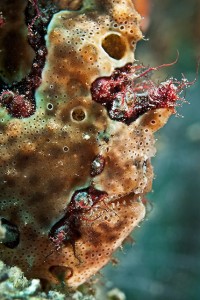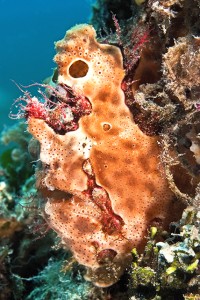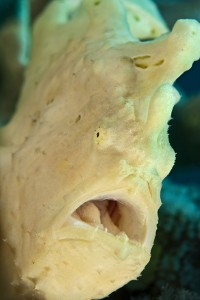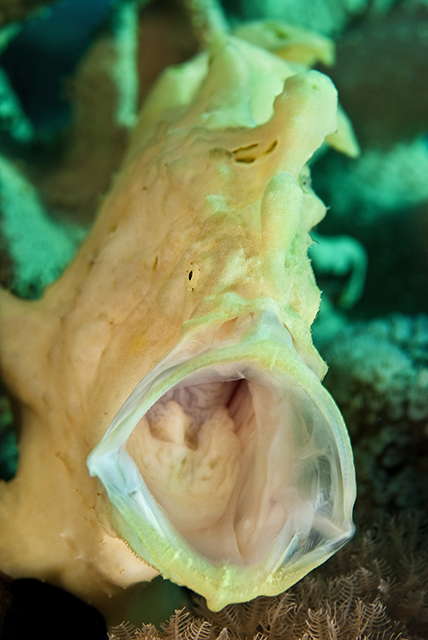News
Resistance Is Futile: Taba’s ‘Alien’ Invasion


 While Taba’s unsuspecting tourists sizzle away in the sunshine, an insatiable predator prepares to strike. This undersea creature lies perfectly camouflaged, armed and extremely deadly. Fish lured into the ambush zone have no escape. Flexible jaws devour in a single, swift gulp. But this strange looking ‘alien’ poses no threat to divers. In fact, there’s no denying it, divers love Frogfish (Antennariidae), and Taba, in northern Egypt, is fast becoming the Red Sea’s top spot for encounters.
While Taba’s unsuspecting tourists sizzle away in the sunshine, an insatiable predator prepares to strike. This undersea creature lies perfectly camouflaged, armed and extremely deadly. Fish lured into the ambush zone have no escape. Flexible jaws devour in a single, swift gulp. But this strange looking ‘alien’ poses no threat to divers. In fact, there’s no denying it, divers love Frogfish (Antennariidae), and Taba, in northern Egypt, is fast becoming the Red Sea’s top spot for encounters.
But what has initiated this increase in ‘alien’ activity, or is it all just a hoax? This definitely had the makings of an X-files mystery? The truth was out there somewhere, so I packed my bags bound for Taba Heights in Egypt. Dan, from Dive Holiday Designers, briefed me en- route: flight ETA – 4 hours; hotel transfer – 45 minutes; accommodation – Intercontinental Hotel;special equipment – Nikon DSLR.
Conditions at Taba are perfect for Froggie spotting. Underwater visibility averages 20 metres throughout the year, currents are virtually non-existent and the majority of dive sites are between 5 – 20 metres. Taba Heights also operates a one boat per site policy so divers aren’t crowding en mass, making the whole experience far more relaxed and enjoyable. A high standard of accommodation and a professionally run dive centre rounded off the facilities perfectly.
There are even some nice shore diving sites where Froggie sightings are virtually guaranteed. At ‘Canyons’ I found 5 different Froggies on a single dive. Huw, the diving manager at Aqua Sport, even told stories of a monster green Froggie that planted itself on his chest during a PADI Advanced Course. This overly friendly Froggie had even been known to sit on a divers head. Huw said ‘It just seems to like divers’.

 Froggies are extremely ugly looking fish but I’m sure this is all part of their game plan. The masters of stealth can mimic their surroundings by changing colour and texture in a matter of minutes growing lumps and bumps similar to the surface of corals or sponges. Passing fish often don’t see the danger until it’s too late. Divers also have a tough time spotting them, but then, that’s all part of the fun. Red Sea Waterworld’s General Manager had even reported sightings on their house reef. A dark brown Froggie had made its home on an upturned parasol that blew into the sea. My findings were becoming more bizarre each day!
Froggies are extremely ugly looking fish but I’m sure this is all part of their game plan. The masters of stealth can mimic their surroundings by changing colour and texture in a matter of minutes growing lumps and bumps similar to the surface of corals or sponges. Passing fish often don’t see the danger until it’s too late. Divers also have a tough time spotting them, but then, that’s all part of the fun. Red Sea Waterworld’s General Manager had even reported sightings on their house reef. A dark brown Froggie had made its home on an upturned parasol that blew into the sea. My findings were becoming more bizarre each day!
Taba’s coastal waters are home to a number of different species of Froggies. But it’s difficult to tell them apart as there are so many variations in colours, shapes and sizes, even in the same family genus. Worldwide, there are around 46 different species. Sizes vary from a few centimetres up to a giant 40 centimetres. At the Radisson Reef (Shaab Gamila) I found a black 25cm Froggie sitting under a table coral and Katie, my dive buddy, spotted another small dark green 5cm Froggie just a few metres away. Andrew said there were two more Froggies sitting on an old fish trap in the sea grass at 10 metres. We had failed to spot them during our afternoon sortie. Male Froggies tend to be smaller than females and there is no differentiation in colours or patterns.
Glassfish Shoals and pinnacles swathed in Anthias (the little orange fish – pseudanthias squamipinnis) are prime Froggie food. But the voracious feeder isn’t fussy; it will even eat its own kind! Froggies don’t have any teeth. Their prey is sucked in and swallowed whole.
 The Glassfish pinnacle at Farun Island is always full of sizeable Froggies. I found three big 20-30cm Froggies camouflaged amongst the coral heads. They are perfect subjects for photographers although it’s not always easy to get a ‘good’ picture. Nine times out of ten they are in a head down position facing towards the reef making it awkward for divers to get a good shot without breaking the fragile corals. Because they are so well camouflaged it’s also difficult to get a picture that looks anything but a lump of coral. The patterned Froggies are the worst. Even with the eye perfectly in focus it is difficult to tell that it’s a fish. I personally think mouth-open shots are the best. As an added bonus Tamer guided us back to the shallows and spotted a bright red 10cm Froggie in just 5 metres. My Froggie count was now nearing double figures in just 4 dives!
The Glassfish pinnacle at Farun Island is always full of sizeable Froggies. I found three big 20-30cm Froggies camouflaged amongst the coral heads. They are perfect subjects for photographers although it’s not always easy to get a ‘good’ picture. Nine times out of ten they are in a head down position facing towards the reef making it awkward for divers to get a good shot without breaking the fragile corals. Because they are so well camouflaged it’s also difficult to get a picture that looks anything but a lump of coral. The patterned Froggies are the worst. Even with the eye perfectly in focus it is difficult to tell that it’s a fish. I personally think mouth-open shots are the best. As an added bonus Tamer guided us back to the shallows and spotted a bright red 10cm Froggie in just 5 metres. My Froggie count was now nearing double figures in just 4 dives!
Froggies have a modified dorsal spine called a lure to attract prey. They use the lure or illiceum just like a fishing rod dangling bait on the end of a line. The shape of the esca or bait can resemble a worm, fish or crab; it will mimic whatever their prey normally eats. Taba’s Froggies all seem to have lures shaped like small fish. They jiggle it about enticing the little Glassfish or Anthias to come closer. This is why Frogfish are also known as Anglerfish.
Froggies aren’t exactly lively creatures. They don’t seem to move very far at all, normally staying in the same place or within a few metres for months on end. This makes the Dive Guides’ jobs nice and easy. They can impress punters with their fish-finding prowess by leading them straight to the Froggie time and time again. At ‘Maxwell’s’ there’s a 20cm purple Froggie that hasn’t moved for more than 2 months. It seems more than happy swaying about on a tube sponge picking off the odd passing fish.
 It’s very rare to see Froggies on the move unless they get agitated by divers or over-zealous photographers poking cameras and flashguns too close. They don’t have swim bladders so can’t swim like conventional fish. It’s more like a ‘walk’ using their modified pectoral fins as legs. For more rapid movement they use a form of jet propulsion, gulping in water and forcing it out from a small opening behind the gills. This produces forward thrust along the seabed.
It’s very rare to see Froggies on the move unless they get agitated by divers or over-zealous photographers poking cameras and flashguns too close. They don’t have swim bladders so can’t swim like conventional fish. It’s more like a ‘walk’ using their modified pectoral fins as legs. For more rapid movement they use a form of jet propulsion, gulping in water and forcing it out from a small opening behind the gills. This produces forward thrust along the seabed.
My week long investigation was reaching an end. Most of Taba’s 17 dive sites had at least one or two resident Froggies. Although when I returned to Taba 2 months later I found that the big Farun Island Froggies had disappeared. All I could find was 2 bright green medium sized Froggies. I had no idea where they had gone or why they had moved. There was some talk that they had ended up in an Aquarium, but this was just a rumour. Maybe they had disappeared into the deep blue to reproduce? Not much is known about their mating habits other than it normally occurs at night. Unfortunately night diving is not permitted at Taba so no one can check out this theory.
This X-files mystery had revealed some startling facts. Taba’s Froggie army is definitely growing fast. I clocked up more than a dozen sightings in just 5 days, some with the most bizarre colours and patterns. There seems to be no set season and they can be spotted throughout the year. Divers should arm themselves with an underwater camera as soon as possible. The ‘alien’ invasion has begun – resistance is futile!
Gear News
Introducing the TR-80, IR-50 and CS-30 Regulators from DYNAMICNORD

Whether you are a beginner or a professional diver – with the three new main regulators from DYNAMICNORD, everyone will find their favourite regulator. They all look super stylish.
Excellent performance with the TR-80
Quality and performance are the be-all and end-all for regulators. It is not for nothing that the TR stands for Tec Reg. The innovative design of the TR-80 guarantees absolute reliability – even in ice-cold waters.

Perfect breathing effort at 0.8 J/l / certified for diving in waters below 10 degrees / structural design made of solid brass for best cold protection / membrane-compensated design with dry seal of the first stage / reduced exhalation effort thanks to optimized exhalation membrane and bubble deflector / adjustable Venturi (dive/predive) and adjustment knob for individual inhalation comfort / innovative design of the front cover prevents free-flow in strong currents or when diving with scooters / design made of sandblasted brass, matt chrome finish / 2 HP and 4 LP outlets / mouthpiece made of high-quality, anti-allergic silicone for maximum comfort.


Amazing underwater adventures with the IR-50
The IR-50 is the top regulator for advanced and experienced divers. Natural breathing is the essence of this regulator.

Ideal breathing effort at 0.8 J/l /certified for diving in waters below 10 degrees / compensated membrane / adjustable venturi (dive/predive) and adjustment knob for individual inhalation comfort/ outlet valve and deflector for minimum exhalation effort and reduction of bubbles on the face / design made of sandblasted brass, matt chrome finish / 2 HP and 4 NP outlets / mouthpiece made of high-quality, anti-allergic silicone for maximum comfort.


The Workhorse – our CS-30
For diving centres and diving beginners – the workhorse stands for strong construction, reliability and robustness. Perfect for your training.

Optimal breathing effort at 0.8 J/l /recommended for diving in waters above 10 degrees / non-compensated piston / adjustable venturi (dive/predive) / outlet valve and deflector for minimum exhalation effort and reduction of bubbles on the face / design made of sandblasted brass, matt chrome finish / 1 HP and 3 NP outlets / mouthpiece made of high-quality, anti-allergic silicone for maximum comfort.


Octopus OP-30
The OP-30 is the ideal addition to all DYNAMICNORD regulators. It is identical in construction to the CS-30.

The TR-80, IR-50, CS-30 (DIN & INT) regulators and the Octopus OP-30 are available from DYNAMICNORD dealers and in the online store.
DYNAMICNORD – Your Outdoor Companion.
Marine Life & Conservation
Paul Watson Released as Denmark Blocks Japan’s Extradition Bid

Renowned anti-whaling activist Paul Watson has been released from custody in Greenland after spending five months in detention. Denmark’s Justice Ministry rejected Japan’s request for his extradition, citing insufficient guarantees that his time already served in custody would be credited against any potential sentence.
The 74-year-old Canadian-American was arrested on July 21 in Nuuk, Greenland’s capital, when his ship docked to refuel. His arrest was based on a 2012 Japanese warrant related to a 2010 encounter in Antarctic waters. Japan alleged Watson obstructed operations and caused damage to a whaling research ship during efforts to disrupt illegal whaling. Watson has consistently denied these claims, maintaining his commitment to marine conservation.
Denmark, which oversees extradition matters for Greenland, concluded that while the legal conditions for extradition were met, the lack of assurances from Japan regarding time-served credit made extradition untenable.
In a video shared by his foundation, Watson expressed gratitude and relief, saying, “After five months, it’s good to be out… and good to know they’re not sending me to Japan.” He added that the most difficult part of his time in custody was being separated from his two young sons.
Watson is a pioneering figure in marine conservation, known for founding the Captain Paul Watson Foundation in 2022 after decades of activism with the Sea Shepherd Conservation Society. His bold efforts to defend marine life have earned him widespread support, including from celebrities and conservationists. His work has also been featured in the acclaimed reality TV series Whale Wars.
Watson’s lawyer, Jonas Christoffersen, praised the decision, stating, “We are happy and relieved that Paul Watson is now free.” He added that Watson is eager to reunite with his family and continue his vital work.
The arrest occurred while Watson’s vessel, the M/Y John Paul DeJoria, was en route to the North Pacific with a team of 26 volunteers to intercept a Japanese whaling ship. His foundation described the arrest as politically motivated and emphasized that Watson’s actions were focused on ending illegal whaling practices.
Japan resumed commercial whaling in 2019 after leaving the International Whaling Commission, asserting that whale meat is a cultural tradition. Conservationists, however, continue to challenge these practices, highlighting their impact on marine ecosystems.
Despite the challenges, Watson remains steadfast in his mission to protect marine life and bring attention to whaling practices. His dedication to ocean conservation has made him a globally respected advocate for the environment.
-

 News2 months ago
News2 months agoIconic SS United States to become the World’s Largest Artificial Reef
-

 News3 months ago
News3 months agoBook Review – 52 Assignments: Underwater Photography
-

 Gear News3 months ago
Gear News3 months agoDYNAMICNORD – New German diving brand enters the British market
-

 News3 months ago
News3 months agoExploring Cenote El Pit: A Diver’s Dream
-

 Gear News3 months ago
Gear News3 months agoTry BARE drysuits (and maybe even win one!) this Friday with Sea & Sea at North West Dive Fest
-

 Marine Life & Conservation3 months ago
Marine Life & Conservation3 months agoBook Review: Coral Triangle Cameos
-

 Blogs2 months ago
Blogs2 months agoDive the Egyptian Red Sea this Autumn with Regaldive
-

 News3 months ago
News3 months ago2024 Ocean Art Underwater Photo Competition Announced

















